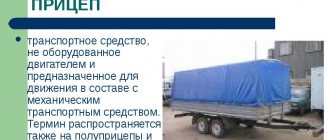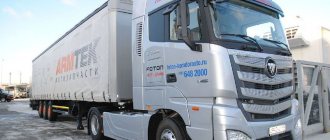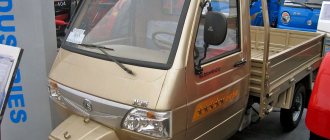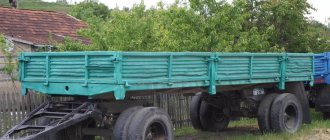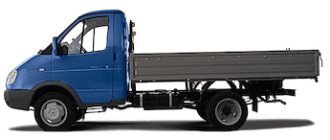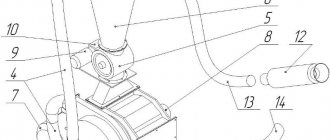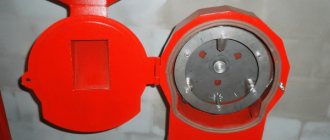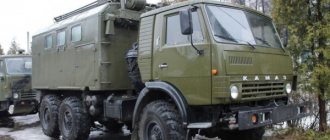Cargo transportation by road has always been in demand. Depending on the nature of the cargo and the transportation distance, transport is selected. When the cargo does not fit into the car, say, in terms of size or quantity, an additional device is attached to the car - a trailer or semi-trailer.
Trailed equipment comes in various types, models, brands, configurations, etc. However, the primary thing is its type - it is a trailer or a semi-trailer. So how do they differ, what do they look like, what types are there, what are trailers and semi-trailers in general?
Curtainsider semi-trailers
Because of their versatility, the most common among carriers are semi-trailers, the body of which is covered with an awning made of PVC material. They can transport almost all types of goods, for which there is no need to create special conditions during transportation. The awning is made of durable materials and protects the cargo from adverse environmental factors such as rain, snow, wind and dust.
The roof of the trailer can be either tented or metal, with removable or movable elements. The frame onto which the material is stretched is made of stainless steel or duralumin, which not only lightens the weight of the structure, but also makes its operation more convenient. The frame is made of all-metal or prefabricated. The latter option is less preferable due to the quality of Russian roads, on which connecting elements can quickly become loose, which will lead to failure of the structure.
The front transom of most curtain-sided semi-trailers is made of metal. This prevents the load from falling onto the cab if the vehicle brakes suddenly. According to their design features, tilt semi-trailers are divided into:
- Curtains. When unloading goods from curtain-type trailers, the awning is simply moved to the side. This allows you to remove cargo from any part of the semi-trailer. The roof can also be folded back. This allows you to use special lifting equipment for unloading work. The top and sides are self-contained. They open independently of each other.
- Curtain-sided. Along the semi-trailer there are special sides that prevent the goods from falling out. Freight carriers have mixed feelings about this type of trailer. Some recommend not installing additional structural elements. This is explained by the fact that cargo can be securely secured in a curtain-sided semi-trailer, but installing sides simply increases the weight of the trailer and makes loading and unloading operations more difficult.
- Flatbed semi-trailers are used for transporting construction and bulky cargo, as well as goods that are not destroyed under the influence of adverse environmental factors. Their sides can be folded down or removed in 1-2 minutes, which facilitates loading and unloading operations.
Curtain semi-trailers can transport cargo weighing up to 35 tons. Transporting goods less than 20 tons is not respectable due to high transport costs. The main disadvantage of such trailers is the low level of protection of cargo from intruders. When the truck is parked, thieves can cut the material and steal the goods.
Classification of trucks by body type
The largest category in the truck classification. There are vehicles with 3 body types:
- Open
- Closed
- Special purpose body.
It is also necessary to highlight cars without a body. These include tractor-trailers, or “heads,” as truckers call them. Instead of a body, they are equipped with a fifth wheel coupling for securing a semi-trailer. A striking example of such a tractor is the Foton Auman BJ4189.
| View | Truck tractor |
| Wheel formula | 4×2 |
| Engine | Diesel, turbocharged, 11.8 l, 473 hp. |
| Transmission | AMT 12-speed, MT 16-speed |
| Gross vehicle weight | 18 tons |
| Gross train weight | 45 tons |
| Load capacity | Up to 37.3 tons with road train |
| Curb weight | 7.6 - 8 t |
| Price | From 4,909,000 rub. |
Types of trucks with open body type
They come in several types:
- Onboard
- Platforms
- Trawls.
Onboard
The first type of car has a low side that acts as a fence. The advantage of this technique is the ease of loading and unloading. However, if the height of the load is higher than the side itself, it must be securely secured. In such a body they transport substances and objects that are not afraid of precipitation, dust and wind. Flatbed vehicles are often used to transport construction materials over short distances.
Some flatbeds, such as the Auman TX1625 (BJ1163) and Aumark BJ 1129, are equipped with a loader crane. The KMU facilitates the loading and unloading of heavy loads. Control is carried out by the driver from the cab. Combining a truck crane and a truck, this equipment saves time and money on loading and unloading operations.
Platforms
An open type of body without sides, which is designed for transporting large and oversized cargo. These include machine tools, large containers, construction equipment, transformers and cable reels, bridge beams, columns, large pipes and other objects. This type of body does not have platforms, so loading is done using cranes.
Trawls
The main purpose of trawls is to transport special equipment and heavy vehicles. Crawler excavators are often transported on trawls, since they are prohibited from traveling on public roads. For ease of entry, low-loader trawls are equipped with special platforms or a folding platform. Such machines, as a rule, have more than 4 axles and a large load capacity.
Trucks with a closed body type
They are divided into several types:
- Tilt
- All metal
- Manufactured goods
- Isothermal
- Refrigerators
- Tanks.
Tilt
The basis is taken as an onboard body type, on which a frame covered with an awning is installed. The advantage of such a body is its lightness. Unlike all-metal and other types of bodywork, the awning does not weigh down the structure, so the carrying capacity of such a vehicle is higher. There are side and curtain awnings. The cargo in such vehicles is protected from the effects of precipitation and dust. There are options for a tilt body with both rear, vertical and side unloading.
All metal
The entire body, including partitions and frame, is made of solid metal. The walls are impact-resistant, and unloading is carried out only through curtains or gates provided for this purpose, so it is almost impossible to penetrate into the body and steal the cargo. Unlike an awning, the metal will not tear, and bulk substances will not be lost along the way. However, this type of body is heavier, which increases the curb weight of the equipment and reduces the carrying capacity. The all-metal body is suitable for transporting objects and substances that do not require special conditions.
Manufactured goods
Manufactured goods vans are used to transport food products that do not require special storage conditions, as well as industrial goods and other cargo. Such vehicles are often used to deliver baked goods. Foton manufactured goods vans of generations C and S provide better protection from dust and precipitation than an awning, but at the same time weigh less than all-metal bodies. The body, made of thin sheet metal, plastic or plywood, ensures the safety of the contents without sacrificing load capacity.
Isothermal
The body is made of metal sheets covered with thermal insulation materials. Thanks to this, a constant temperature is maintained inside, which is necessary for the preservation of perishable products. Unlike refrigerators, an isothermal body cannot regulate the temperature by lowering or raising it. For the transportation of large and heavy loads, Foton offers an insulated van Auman TX1625 (BJ1163) with a load capacity of 10.5 tons. It is suitable for transporting large quantities, both within the city and to neighboring settlements.
Refrigerated
As in an isothermal truck, the body of the refrigerator is lined with thermal insulation materials. But unlike it, the van is also equipped with refrigeration equipment. Thanks to this, it can transport meat, fish, dairy products, frozen semi-finished products and other perishable products.
Refrigerators are divided into several classes:
- “A” - permissible temperature from 0 to +12 degrees
- "B" - from -10 to +12
- "C" - from -20 to +12
- “D” - temperature in the body is not higher than +2
- "E" - no higher than -10
- "F" - no higher than -20 degrees.
Tanks
Serve for delivery of overflow cargo. The tanks are made of steel or aluminum. Some tanks have sections to transport different types of substances without mixing them. Some bodies are equipped with a device for continuous mixing of substances, while others are equipped with a special casing for heating the mixture. Thanks to this, any substances, be they liquids or gases, are delivered safely and do not lose their properties.
One of the varieties is tank containers.
Trucks with a special body type
These include:
- Dump trucks
- Garbage trucks
- Tow trucks
- Onboard with CMU.
Tankers
Tanks transport liquid cargo, such as fuel, milk, water, etc. To transport liquids intended for food consumption, you must obtain the appropriate certificates. The semi-trailers themselves undergo sanitary treatment after each trip.
The inner surface of the tank is divided by bulkheads and covered with special materials that cannot enter into chemical reactions with the cargo being transported. In essence, it is a sealed container equipped with equipment for filling and emptying. It uses a system of valves and sluices.
In addition to transporting liquid cargo, tanks can be used to transport flour, grain or mineral powder.
Cement tankers
They are designed to deliver cement to sites located far from railway tracks. The semi-trailer is capable of providing building materials to both small and large enterprises, as well as private customers.
The main structural element of a cement tanker is the tank. In its inner part there are air trays, thanks to which air is continuously supplied to the cement. This prevents it from hardening. A semi-trailer can transport up to 120 tons of cement.
The tank is installed on the support frame at a slight angle. This is done to facilitate unloading of material. Cement is poured through the top hatch. A ladder and platform are installed on the outside of the semi-trailer. This makes the structure easier to maintain.
From the tank where the cement mortar is prepared, a hose is fed into the tank, through which the load moves by gravity. After the semi-trailer is fully loaded, the tractor tows it to its destination. Upon arrival at the site, a hose is connected to the tank unloading valve, the other end of which goes into the receiving tank. To speed up unloading, air is supplied to the cavity of the tank.
An important part of a cement truck is the compressor. During transportation, it prevents the material from freezing, and during unloading it speeds up the process. Designs of this type are equipped with three or more axes. The main advantage of transporting cement by semi-trailer is the complete automation of the process. The equipment itself carries out loading and unloading operations. The tank is driven by a truck-type tractor. It also takes on part of the load from the weight of the cargo.
Refrigerators
If the cargo can only be transported under certain temperature conditions, for example frozen food, it is transported in semi-trailers equipped with refrigeration units . The sides of the truck are made of various metals or hard plastic using sandwich panel technology.
The insulating base is a foam material that is resistant to moisture and temperature changes. This eliminates contact of the transported goods with the external environment. The refrigeration unit located inside the semi-trailer maintains the air temperature in the range from -25 to +25°C.
One of the subtypes of refrigerators are isothermal semi-trailers. They are designed for transporting products with a short shelf life within one city. We can say that this is a huge thermos that does not allow the cargo to come into contact with the environment, but at the same time cannot ensure its long-term storage.
Container ships
Containers with cargo are transported on a semi-trailer. The products are mostly the same size. This makes it possible to equip trailers with a universal rigging system. Container ships are divided into 2 categories:
- standard, with a frame length of 12.5 m, which can transport 2 20-foot containers;
- low-loaders, designed for the transportation of dry cargo containers.
Many models are equipped with telescopic devices, thanks to which you can, if necessary, change the size of the structure based on the characteristics of the cargo being transported. Front and rear platforms make loading easy.
Trawls
They are also called low loader heavy trucks. They are designed for transporting goods of non-standard sizes or heavy weight. Trawls are used to deliver construction, agricultural and other equipment to the work site. The semi-trailer frame is low. This makes it possible to transport oversized cargo without fear of damaging power lines and other low structures when moving.
Trawls are equipped with a telescopic system and have retractable elements. To allow equipment to enter the site, heavy trucks are equipped with special ramps. The weight of the semi-trailer varies from 6 to 8 tons. The number of axles, some of which are equipped with rotating mechanisms, is greater for trawls than for other types of semi-trailers. This is done to increase the wear resistance of the structure, as well as to reduce dynamic loads.
Classification of freight transport by operational characteristics
By number of axes
By the number of axes there are:
- 2-axle
- 3-axle
- 4-axle
- 5-axis
- 6-axle.
The number of axles directly affects the load capacity, since each axle can “accept” a limited number of tons. The more axles, the heavier the loads.
According to the wheel formula
The wheel formula is indicated by 2 numbers. For example, 4x2 or 6x4. The first number is the total number of wheels, and the second is the number of drive wheels.
If you do not deliver goods through sand pits, taiga swamps or snowy deserts of the North, but move mainly on asphalt, a 2-axle van with a 4x2 wheel arrangement is quite enough for you. A car with a more powerful chassis will be more expensive and more difficult to maintain. In addition, fuel consumption on such vans will also be higher.
By load capacity
According to their carrying capacity, trucks are divided into 4 classes:
- Small (from 500 kg to 2 tons). A striking example of a light-duty van is Foton Aumark BJ1039
- Medium (from 2 to 5 tons). Examples - Foton S models: S065, S085.
- Large (from 5 to 16 tons). Representatives of the large class in the Foton line are Aurmark BJ1089, BJ1129, Auman BJ1163 and the Foton Auman BJ4189 truck tractor.
- Extra-heavy or large-tonnage (from 16 tons and above).
By gross weight
When choosing a truck, in addition to the carrying capacity, you also need to take into account the total weight. This is the maximum permissible curb weight of the vehicle including cargo, driver and additional equipment. It is calculated based on the load on the individual axles of the truck.
Based on gross weight, trucks are divided into 7 categories:
- up to 1.2 tons
- from 1.2 to 2 tons
- from 2 to 8 tons
- from 8 to 14 tons
- from 14 to 20 tons
- from 20 to 40 tons
- over 40 tons.
The vehicle's load capacity and gross vehicle weight must be selected according to the load being transported. If you exceed the weight, the vehicle may not be able to withstand the load. Therefore, there is a fine for exceeding the permissible values. If the load capacity characteristics significantly exceed the weight of the cargo being transported, the vehicle will not justify itself.
By engine type
Based on the type of power unit, vehicles are divided into:
- Gasoline
- Diesel
- Gas.
Gas -powered trucks
, are the most profitable in terms of fuel consumption. However, such machines are rare. Few gas stations are capable of refueling gas engines of vans and tractors, which is why there are few such vehicles in our country.
Gasoline
motors are lighter and quieter. They start easier in cold weather and do not need to warm up for a long time. Unlike diesel units, gasoline engines have better dynamic characteristics and provide faster acceleration. The main disadvantage of cars with gasoline internal combustion engines is not the greatest torque, which affects the load capacity. Therefore, as a rule, such vehicles are used for intracity transportation of small and medium-class cargo.
Heavy-duty tractors predominantly use diesel
fuel. Such engines are economical and productive. Previously, the disadvantages of such engines were a high noise level and a large volume of exhaust gases. However, modern diesel engines are almost no different from gasoline engines in terms of noise. Moreover, most power units installed on Foton cars meet Euro 5 requirements.
Car transporters
This is a type of trawl designed for transporting cars over long distances. Loading of cargo is specific here. There must be free space between vehicles, otherwise they will become unusable at the first imperfection in the road. The cars are secured with special devices that ensure complete immobility of the equipment while driving. Car carriers transport both passenger cars and trucks.
There are several types of car transporters:
- Single and double tier. Designed for transporting standard car models in large quantities.
- Side and tilt. They transport high-value vehicles, for which they try to provide additional protection from rain, dust, dirt, etc.
- Closed. They are used when transporting rare cars or in cases where it is necessary to hide information about the quality and quantity of transported cargo. Enclosed semi-trailers eliminate the possibility of any adverse environmental factors affecting the transported vehicles. Available only in a single-tier version.
On average, a car transporter can accommodate 8 cars or 3 minibuses. A semi-trailer of this type is used if it is necessary to move new cars over long distances without causing damage to their suspension and appearance.
What is the difference between a trailer and a semi-trailer?
Not every driver will be able to give a clear and competent answer to this question. But in fact, everything is simple: their fundamental difference is in functionality.
A complete list of documents required to issue a card.
Trailer
Moves in combination with a truck or car when mechanical force is applied. Despite the lack of an engine, it is classified as an independent vehicle.
Semitrailer
It is not considered independent, since to move it needs support - a tractor. Without it, he is unable to maintain balance.
There are also some differences in maneuverability. When driving a truck with a trailer, the driver must have special training and experience, because such a vehicle is extremely clumsy due to its size. It's hard to guess how it will behave on the road. As for the semi-trailer, everything is much simpler with it: its behavior is predictable, repeating the movements of the truck.
Semi-trailer dump truck
They are mainly used for transporting materials for construction and agricultural purposes. Typically this is:
- soil and fertilizers;
- corn;
- ore;
- coal;
- sand;
- crushed stone
The semi-trailer body is made of all-metal sheets. It is tilted either by a hydraulic lift or a telescopic cylinder. The driver can control the process directly from the tractor cab, because The operation of the lift is carried out thanks to the drive of the power plant.
Materials are unloaded through the stern or side. In agriculture, priority is given to the latter because Loads often have to be dumped indoors. The rest of the organizations mainly purchase semi-trailers with rear unloading semi-trailers with rear unloading.
The body is made of steel or aluminum. The former are used for transporting bulky, light weight cargo. The second ones are designed for transporting heavy materials. All models are equipped with a reinforced frame.
The shape of trailers of this type are semicircular, for quick unloading of bulk cargo, and square, which are suitable for solving various transport problems. In the latter case, the trailer can transport not only bulk goods, but also other types of cargo.
Refrigerator and isothermal semi-trailer
In many cases, the transported cargo requires a certain temperature regime - frozen foods, flowers, vegetables and fruits, medicines, etc. Isothermal semi-trailers are able to maintain a certain temperature inside due to heat-insulating walls and high tightness - for example, a thermos works on the same principle. No special equipment is required for this, so isothermal semi-trailers have a relatively low weight. But the set temperature is maintained for a limited period of time, most often several days. There is a conditional division of the isotherm into “thin” and “thick” - we are talking here about the thickness of the panels of the semi-trailer, on which the period of maintaining the climate inside the container depends. The price of an isothermal semi-trailer directly depends on this parameter.
Refrigerators are semi-trailers, inside of which a refrigeration system with fans is additionally installed to evenly distribute cold air. The temperature range inside the container depends on the type of semi-trailer, there are three of them - A (0°C – +12°C), B (-10°C – +12°C) and C (-20°C – +12°C) [6]. Floors and doors with a reliable locking system are subject to additional sealing.
Let's consider the Chereau CSD 3 refrigerator. In the basic configuration, it has a three-axle design, steel wheels, and a WABCO EBS E braking system. The semi-trailer is equipped with a Carrier MAXIMA refrigeration unit, designed for deep freezing of products, with electric start and auto shutdown. The permissible total weight with cargo must not exceed 39,000 kg.
Prices for new isothermal [7] semi-trailers and refrigerators [8] average from 2 to 4 million rubles. An economical choice could be MAZ-Kupava; in the middle price segment, Kogel can be noted, and more expensive options are represented by the Kassbohrer and Krone brands.
Semi-trailer dump truck
They are often used in agriculture and the construction industry. The semi-trailer dump truck is designed for transporting bulk materials - sand, earth, crushed stone, coal, etc. The classic body shape is considered to be semicircular; when loading, large particles roll down along the side, so the impact load is significantly reduced. There are also rectangular dump truck semi-trailers; they can be used to transport boards, bricks, slabs, etc.
Semi-trailers-dump trucks are distinguished by the type of unloading. Rear unloading does not require a complex design and does not significantly affect the weight. But in a room with limited space (with a low ceiling), rear unloading may become impossible. In such cases, a dump semi-trailer with a side loading system is required. There are also universal (three-sided) models.
You can also note semi-trailers-dump trucks with an aluminum body - they have a good margin of safety and, which is important in cargo transportation, have less weight. Suitable for transporting bulky, light loads.
The cost of dump semi-trailers ranges from 1.7 to 3 million rubles [9] depending on the brand, characteristics and load capacity. In the low price segment there are brands such as Tonar, mid-priced brands are Wielton and Grunwald, and Schmitz has the highest prices.
One example of a classic dump semi-trailer is the Wielton NW 3S 33 HP [10] with a steel round body and a rear unloading system. The model's load capacity is 42,000 kg.
Container ship
Another universal way to transport goods of various types is the use of special metal containers. To transport them, container ships have been developed, which are a kind of flat platform with a set of characteristic fastenings. Loading and unloading is carried out using lifting equipment.
Some manufacturers offer telescopic structures, the length of which can be changed as needed. For example, the Wielton NS 3 container ship [11] has retractable front and rear parts, suitable for transporting containers from 20 to 45 feet.
The market for semi-trailers and container carriers is represented by the brands Tonar (economy class), Wielton and Kassbohrer (middle class) and Schmitz, Kogel (high price category). On average, their prices are in the range of 1–2 million rubles [12].
Car transporter
With the advent of semi-trailers for transporting vehicles, delivering cars to different cities and countries does not pose any particular difficulties. Typically, one car transporter can accommodate about 8 sedans, 5-6 SUVs or 2-3 minibuses. The structure often has several tiers, and can be tent or side. Cargo racks are required.
The advantages of using a car transporter over driving a car yourself are obvious - the condition of Russian roads is such that long-term driving on them can deprive the car of its marketable qualities. And compared to rail transportation, this method is faster and less expensive.
It is important! When choosing a car transporter, pay attention to the width - for example, domestic models of semi-trailers are not always suitable for transporting foreign SUVs.
The cost of new car transporter semi-trailers is about 1.5–2.5 million rubles [13], but at the moment there are much more offers for the sale of used models than new ones. Common brands are Rolfo and Lohr.
The Lohr SHR 8/4 S2M59X [14] car transporter is designed to transport 8 cars. It has a lightweight loading system, air suspension, autonomous hydraulics, 16 fastening belts with a tensioning mechanism.
Tank semi-trailer
This type is suitable for transporting bulk and liquid products. Depending on their purpose, vehicles are divided into fuel tankers, oil tankers, gas tankers, milk tankers, cement tankers, etc. The internal structure of the tank is important here - for example, a protective anti-corrosion coating is used to transport water. And transportation of aggressive and caustic substances requires more durable alloys that are insensitive to them.
For example, the SA STOKOTA NV 1-30-4 fuel tanker [15] is equipped with an aluminum alloy tank and is suitable for transporting light petroleum products, alcohol and mineral oil with a total volume of up to 30,000 liters. Has 3 axles with automatic lifting device at the front.
Note! Special requirements apply to tanks for food products - they must be equipped with special filters, safety valves, pumping units, etc.
Prices for semi-trailers-fuel trucks can vary - it all depends on the purpose, capacity and manufacturer. On average, their cost ranges from 1.5 to 5 million rubles. [16] The economy segment is represented by Bonum tanks, for an average price you can buy Stokota, and the more expensive ones include Kassbohrer.
Heavy truck
Another name for this semi-trailer is trawl. It is needed for moving large and heavy loads, such as construction and agricultural equipment, drilling rigs, bulldozers, crawler tractors, etc. The design may have sides and a rear dolly. Heavy-duty trucks are characterized by their low height, which allows them to transport cargo without fear of hitting power lines, and to move through tunnels and under bridges.
The heavy-duty truck can be equipped with a telescopic system or have retractable elements. The three-axle trawl Wielton NJ 4 (R) [17] has a sliding frame made of high-strength steel, which adds 5 meters to the length of the heavy truck, with the possibility of fixing every half meter. Load up to 46,000 kg.
The price of a heavy semi-trailer depends on its carrying capacity and on average ranges from 2 to 3.5 million rubles [18]. Inexpensive brands include TEKHOMS, in the middle price range you can buy Kassbohrer, and a more expensive brand is Wielton.
Van semi-trailer
The design resembles a tent one, but instead of fabric it has hard walls. This significantly increases transportation safety, but the weight, and, as a result, the carrying capacity of a van semi-trailer is lower. Broken gates require more attention - while the awning can be temporarily patched, repairing the lock should be carried out by a specialist. The distinctive features of the van are its rectangular shape and a gate on the rear wall. Models with a frame are sheathed with moisture-resistant plywood or plastic, frameless options are made of galvanized sheet.
Van semi-trailers for trucks cost more than tent ones, on average about 2.5–3 million rubles [19]. One of the popular models is the Wielton NS 3 F [20] with a plastic body made of 20 mm thick panels. The front wall and roof are reinforced and have a thickness of 25 mm. The gate is made of aluminum. Has isothermal properties.
Industry-specific semi-trailers
You can also select semi-trailers designed for transporting farm animals and specific cargo.
A livestock carrier is usually equipped with several floors, the height and number of which can be adjusted depending on the size of the animals. It has ventilation grilles and is often complemented by drinking bowls and internal lighting.
Chip trucks are needed for transporting logging waste, as well as other light bulk cargo. They often have a sliding floor, which allows the semi-trailer to be unloaded without the use of lifting mechanisms.
Timber trucks are equipped with special racks that serve as holders of wood logs or boards. Loading and unloading occurs using manipulators or cranes.
Van semi-trailer
It is used to transport various goods that do not require special temperature conditions. Most often these are food products and industrial consumer goods.
A semi-trailer van can be used for a variety of purposes. They are equipped with mobile laboratories and pavilions, places for passengers and equipment. The trailer can be used to transport bread, computers, etc.
The design of the van resembles a tilt semi-trailer, but instead of PVC material, waterproof plywood, galvanized sheets, plastic or sandwich panels are used. In addition to the rear door, the trailer can also be equipped with a side door, which will allow you to assess the condition of the cargo without opening the stern gate.
If the semi-trailer is intended for transporting products or goods, it is equipped with cells where boxes with cargo can be fixedly fixed. Vans are produced in one-, two- and three-axle versions.
Livestock trucks
Designed for transporting animals. This is one of the variations of a cargo semi-trailer. Transporting livestock is necessary for agriculture, sports and personal purposes. Design features depend on the size and type of animals being transported. If factors are not taken into account, the livestock will be injured or even die.
Livestock semi-trailers have up to 4 tiers. If necessary, they can be disassembled or combined. The tiers move thanks to the hydraulic system. On some models, the height of the side walls is adjustable. This is done to provide the animals with proper lighting inside the truck.
Some semi-trailers are specialized for transporting only a certain type of cargo. If it is cattle, the trailer will have one tier and is additionally equipped with fixed sides. Transporting pigs in such a semi-trailer without additional equipment is dangerous. Livestock may be injured during travel.
Transportation of several types of animals at the same time can be carried out in multi-tier semi-trailers. For example, on the first level there are pens with rams, and on the second level there are cages with birds.
Unlike conventional vans, a livestock carrier has a number of design features:
- The interior space is divided into sections, which prevent animals from concentrating in a specific area of the trailer. Thanks to this, the center of gravity of the semi-trailer will always be in one place. This prevents the truck from tipping over.
- The bottom is made of high strength materials and has a corrugated surface. This is done to prevent animals from slipping and falling while the livestock truck is moving. If large and violent animals are transported, for example, bulls, the interior of the body is additionally equipped with hooks and fastening rings.
- The body is made of high-strength materials that can hold even heavy and wayward animals in place.
- To avoid injury to four-legged passengers, the inside walls are made as smooth as possible.
- Depending on the type of livestock being transported, the semi-trailer is additionally equipped with pens, beams, and cages.
- For some animals, a lighting, water supply, cooling and air disinfection system is equipped.
Particular attention is paid to ventilation on livestock carriers. Air ducts are made along the entire perimeter of the body, except for the rear gate. Their size is determined by the parameters of the cargo being transported. The larger the cattle are in the body, the more developed the ventilation systems should be. At the rear, the semi-trailer is equipped with a loading and unloading lift, which resembles a small elevator. Some livestock carriers use an inclined ladder for this purpose.
STAS model range for coupling with tractor
As noted above, STAS has 10 basic semi-trailers with the possibility of personalization. Let's look at the three most famous and functional models. These are Agrostar, Biostar and Farmstar, which are good without additional options.
Agrostar
A robust classic dump truck with 14 body styles ranging from 45 to 79 m3. Ideal for agricultural products, waste and fertilizers, and also performs well in transporting finished products. Aluminum body, steel/aluminum chassis, stable and lightweight. High-quality hydraulic cylinder, stable operation in any weather and constant availability in the warehouse - this is about the leading STAS Agrostar dump truck.
Biostar
Multifunctional mobile floor semi-trailer for almost any standard cargo (except for the heaviest types of scrap metal and large construction waste). Designed for the agricultural industry, Biostar is suitable for woodchips, sawdust, waste paper, fertilizers, biomass and a wide range of agricultural products. Finished packaged products are also easily transported in this versatile semi-trailer. The aluminum body is completely welded, the structure is self-supporting, and the chassis is made of steel and aluminum alloys. The volume of a semi-trailer from more than 70 cubic meters to almost one hundred cubic meters will increase the efficiency of transportation in any area.
Farmstar
Capable of storing goods on pallets and in big bags, Farmstar is designed for the agricultural sector. Compact, with low dead weight, it can provide intensive logistics of grains, vegetables, fruits, legumes and other crops. Farmstar can also handle fertilizers, feed and slaughter waste. Due to its size and maneuverability, it is perfect for working indoors, for example, for unloading into waste pits. 12 volume options from 52 to 81 m3, lightness and strength make Farmstar an excellent choice.
Chip trucks
The chip truck is used for transporting wood chips, shavings and other waste from wood processing enterprises. The design resembles vans, but has a number of features:
- tailgate;
- hydraulic body lift;
- movable bottom and roof.
Loading of cargo onto a chip truck is carried out from a conveyor belt or bunker. To be able to accept cargo in this way, semi-trailers are equipped with an automatic system for folding the top cover.
To unload chips, the driver opens one of the sides, and the cargo spills out due to its own weight. However, some chips remain in the body, which will have to be removed manually. To avoid this, hydraulic lifts are installed on some models.
The moving floor is installed on long semi-trailers and chip trucks. After the vehicle arrives at the unloading point, the driver opens the rear gate and starts the hydraulic system. She moves the floor slats back and forth. At the same time, the front wall of the trailer begins to move. Due to the combination of these factors, the wood chips gradually leave the interior of the semi-trailer.
Possible additional options
Improving and simplifying routine operations is one of the goals of STAS, which is realized with the help of high-tech semi-trailers and their options. To fully evaluate the capabilities of the equipment and gain the best operating experience, select the necessary solutions - there are many of them.
The line of options includes closing systems, hydraulic doors, additional windows and doors, ventilation grilles, slings and fastenings, options for washing equipment, lighting and personalization solutions and much more. Let's take a look at the most popular ones.
Closing systems. Awnings are an important and necessary thing for most cargo, covering the transported materials from the effects of precipitation. Closing systems differ in the type of control (manual and automatic), but the expectations are the same. Standard ones perform their functions well, but there are also specialized ones that are more durable.
Cramaro Overquick closing system. The best of the automatic ones, strong, able to cope with gusts of strong wind and accumulation of moisture.
Sandnet. This is the same Cramaro Overquick, only simpler and lighter. Control is both manual and automatic.
Protective covers for walls. If you plan to transport abrasive materials in a semi-trailer, you can use special linings that protect the walls from negative impacts. There are options for dump trucks and models with a moving floor.
Doors. High-quality and comfortable rear doors with hydraulic drive are indispensable for transporting wet cargo, bulk materials and other cargo that is demanding on conditions. An automatic drive will allow the driver to open and close the door without leaving the cab.
Sealed door for wet loads
Two way waterproof door for dump truck
Rear door with 4 locks
Door with additional grain hatches
Other systems and options
Cleansweep for cleaner unloading with moving floor mechanism.
Increased load capacity. This feature can be easily realized by installing a chassis with a stepped frame. It can be lowered from the support legs to the tail section. This way you can increase the volume without increasing the overall height. In addition, the center of gravity of a loaded semi-trailer is slightly reduced, increasing transportation safety.
STAS takes into account all customer requests, designing a semi-trailer taking into account all requirements. In any case, premium quality, reliability of every detail and long service life will remain unchanged.
Timber trucks
The main purpose of a timber truck is to transport wood from its harvesting sites to warehouses and processing plants. Their distinctive feature is the ability to operate in severe off-road conditions. Large material of non-standard sizes is loaded onto the semi-trailer. In addition to logs and boards, the timber carrier can be used to transport pipes.
Semi-trailers of this type have their own design features:
- Koniks. During transportation, logs are fixed with special vertical supports - bunks. They are located symmetrically on both sides of the semi-trailer. To facilitate loading and unloading operations, on some models the bunks are made sliding.
- Chassis and axles. They are given special attention on timber trucks. Semi-trailers are used in off-road conditions, so the chassis and axles are made more durable than other types of trucks.
- Fastening elements. To prevent logs from slipping out while the vehicle is moving, timber trucks are equipped with fasteners and safety bars. One of them must be mounted on the semi-trailer on the driver's side. The logs themselves are tied with thick cables before transportation.
Timber trucks have a high carrying capacity. Their design differs from standard trawls only in the presence of bunks and increased maneuverability, which allows loading directly at the logging site.
Features of semi-trailers
A semi-trailer is a vehicle - a type of trailer that must necessarily rest on the frame of the tractor. The semi-trailer cannot maintain its balance on its own. When parking, it is necessary to use support posts and axles; reliable fixation is required. Semi-trailers are less likely to overturn and behave predictably in any road conditions.
The semi-trailer body is designed to transport a large volume of cargo, the weight of which is evenly distributed. For large-scale cargo transportation, it allows you to reduce the cost of transport services. Semi-trailers vary in technical characteristics and purpose.
What is a semi-trailer
Regardless of the specific type, a semi-trailer cannot move independently. It is driven by a tractor-type tractor. The semi-trailer is connected to the tractor with its front part, which increases its maneuverability. The trailer axles are in most cases located closer to the stern. Now there are about 500 types of semi-trailers, each of which is designed to transport a specific type of cargo. The main advantages of the semi-trailer are:
- wide selection of models;
- the ability to transport cargo that requires special storage conditions;
- beautiful appearance;
- increased security;
- high maneuverability;
- large load capacity.
The only disadvantages of semi-trailers are their high cost and the difficulty of coupling with a tractor. However, these unpleasant moments are compensated by the wide functionality of the design. The driver can predict the behavior of a semi-trailer on roads of any category. Thanks to the uniform distribution of the load along the entire length and width, the structure rarely overturns.
In order for the tractor to be connected to the semi-trailer, a special type of support unit is needed. It is a platform with a kingpin, which fits into the saddle of the driving system. The serviceability of the fasteners plays an important role here.
The couplings are:
- universal;
- trailed;
- semi-trailer
Semi-trailers are considered the ideal solution for transporting cargo weighing over 10 tons over a distance of more than 100 km.
How are trailers and semi-trailers similar?
Having understood what a semi-trailer and a trailer are, as well as the difference between them, you need to emphasize 2 points that unite them:
- Sphere of destination - both types of equipment are used in the field of long-distance cargo transportation: products, transport, building materials, etc.
- An important part of a general road train, a combined type of transport, i.e. tractor + trailer.
Before the trip, it is necessary to carry out calculations and complete documents. Drivers are required to ensure the safety of their vehicles on the road. There are significant differences between the trawls in terms of control, appearance and functionality.
You cannot drive a vehicle without documents
What is a trailer
A trailer is a separate type of transport that does not have an engine. Its main difference from a semi-trailer is in the method of attachment to the vehicle and the location of the axles. The tractor tows it thanks to a towbar to which a drawbar is attached. The trailer axles are located both at the front and at the rear. Because of this, their maneuverability is significantly lower than semi-trailers.
Those. if a semi-trailer resembles a two-wheeled wheelbarrow in its design, then the trailer will be identified with a four-wheeled cart. For a semi-trailer, the weight of the load is evenly distributed between its chassis and the tractor; for a trailer, on the contrary, the entire load falls on its own axles. He only needs a tractor to set the structure in motion. However, trailers have a number of advantages:
- versatility;
- low price;
- ease of operation;
- good off-road performance.
The main disadvantages include poor maneuverability, low load capacity and functionality. The trailer may overturn when making a sharp turn at high speed.
Also in the FAQ section you can find answers to your questions, such as:
- Is it possible to deliver equipment to other cities?
- How to properly load a trailer?
- What is the service life of trailers and semi-trailers?
- What are the penalties for overloading a trailer?
- What is the difference between a trailer and a semi-trailer?
- Is trailer registration required?
- Is it necessary to pay transport tax on a trailer?
- Where is the VIN number located on the trailer?
Latest articles All articles
25.03.2021
What types of semi-trailers are there for trucks?
08.09.2021
Tipper semi-trailers - features
08.09.2021
How to hitch a semi-trailer to a tractor-trailer?
Every young driver who is just starting his career in the trucking industry inevitably encounters difficulties when coupling a semi-trailer to a tractor-trailer. To do this, the driver just needs to correctly position the semi-trailer and carefully drive up to it on the tractor, using reverse gear, while hitting the corresponding groove of the fifth-wheel coupling device to engage the semi-trailer's kingpin with the saddle lock (SCL) of the tractor. You can find out how to properly connect a tractor and a semi-trailer in the WIELTON video instructions.
